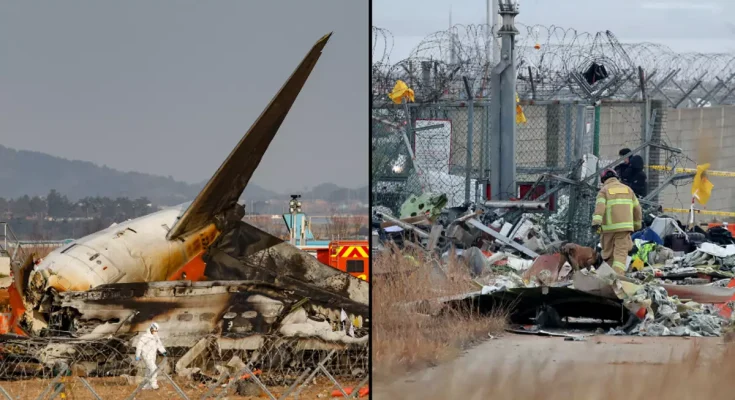South Korea’s transport ministry have revealed that the Boeing 737-800’s black boxes are missing crucial data
South Korean officials investigating the Jeju Air plane crash have issued a worrying update after analysing the black boxes which were retrieved from the wreckage.
Authorities had hoped that the electronic recording devices would provide an insight into what happened in the final moments before the disaster on 29 December.
The Boeing 737-800 which was carrying 181 people had departed from Bangkok, Thailand, and crashed following an emergency landing at Muan International Airport.
Only two cabin crew members survived the fireball after the jet ploughed into a concrete wall at the end of the runway.
The pair – who have both struggled to remember what happened during the incident – were found in the plane’s tail section with several injuries.
Investigators announced they had began extracting data from one of the black boxes on the Jeju Air jet at the start of the month.
South Korea’s transport ministry said this content from the cockpit voice recorder would then be converted into an audio file.

The black boxes from the doomed Jeju Air jet stopped recording four minutes before the crash (JUNG YEON-JE/AFP via Getty Images)
The second black box – a flight data recorder which was damaged in the crash and missing a crucial connector – was then sent to the US for further analysis.
The Ministry of Transport’s director of aviation policy, Joo Jong-wan, explained at the time: “We have determined that extracting data from the damaged flight data recorder here is not possible.
“And so we have agreed with the NTSB to send it to the US and analyse it there,” he said, according to Yonhap News Agency.
However, in the latest update on the probe into the worst airline disaster South Korea has ever seen, the ministry has revealed that both devices stopped working just minutes before the crash.
Four minutes before the disaster, the cockpit voice recorder and the flight data recorder stopped processing data.
The US National Transportation Safety Board discovered the missing chunk of information while analysing the contents of the black boxes.
But according to South Korean officials, other data was available which could aid the investigation.
As well as this, they reassured families of the victims that the probe would be transparent and information would be shared with them.
Sim Jai-dong, a former accident investigator for the transport ministry in South Korea, said the malfunction of the black boxes was extremely surprising.
He said that it suggests that the aircraft could have lost all power, including backup, which he says would be an ‘incredibly rare’ occurrence.
Black boxes are designed to withstand a lot of trauma and are considered to be almost indestructible.

South Korea’s transport ministry are working to determine what happened to the devices (JUNG YEON-JE/AFP via Getty Images)
Typically located at the rear of an aircraft, these devices can survive extreme temperatures and underwater immersion, but they are not completely unbreakable.
They collect flight data such as speed, altitude and fuel levels, as well as voice recordings from inside the cockpit.
The devices can also pick up on other sounds such as engine noises and radio transmissions, which was the case with the fateful Voepass Linhas Aéreas Flight 2283 crash in August last year.
US aviation expert Frank E Turney explained why the data from black boxes is so important for investigators to get their hands on.
The chair of the aviation department for Capitol Technology University previously told The Guardian: “The [black] box or the flight data recorder is not going to sit there and tell you this is what caused this accident.
“What it’s going to do, it’s going to give you all of the underlying factual data that you can use to try to assess how the accident occurred.
“Sometimes the data that you’re getting from the flight data recorder will be very conclusive on what the cause of the accident was, but most of the time it is going to be a piece of the overall investigation, and not necessarily a slam dunk on ‘this is what caused this accident.'”
According to Turney, there is usually a chain of unfortunate events – known as the ‘accident chain’ – which lead up to an air disaster, rather than one single issue.
He reckons that officials will be looking into the structure of the Jeju Air plane, its mechanics and how the pilots handled the situation.
“They’re going to go through all of that, and then at some point they’re going to sit down and go through all of this information to figure it out,” Turney added.
“But the flight data recorder is usually a fairly sizeable piece of the puzzle that they use to determine the accident.”
Featured Image Credit: Chris Jung/NurPhoto via Getty Images/Chung Sung-Jun/Getty Images



